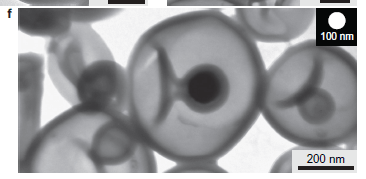NNNS Chemistry blog
Prevous: The perfect samarium iodide recipe
Next: Definition organocatalyst corrupted
The stomatocyte rocket
05 April 2012 - Making It move VIII
 This blog by now has a fishtank full of autonomous moving chemical entities (see making-it-move part VII) and the latest creature making the splash has been designed by Wilson/Nolte/van Hest as reported in Nature Chemistry (DOI). It is all about a polymersome which is a hollow vesicle in the micron range with a membrane made from an amphiphilic synthetic block copolymer, usually investigated as a drug delivery agent. WNvH envisioned a polymersome rocket with a little opening allowing the entry of hydrogen peroxide as the fuel and filled with a platinum nanoparticle (PtNP) as the motor. The thrust is then provided by the catalytic conversion of hydrogen peroxide to water and oxygen which escapes as bubbles from the vesicle gap as the nozzle . But how to make one of those vesicles and how to trap Pt particles inside them?
This blog by now has a fishtank full of autonomous moving chemical entities (see making-it-move part VII) and the latest creature making the splash has been designed by Wilson/Nolte/van Hest as reported in Nature Chemistry (DOI). It is all about a polymersome which is a hollow vesicle in the micron range with a membrane made from an amphiphilic synthetic block copolymer, usually investigated as a drug delivery agent. WNvH envisioned a polymersome rocket with a little opening allowing the entry of hydrogen peroxide as the fuel and filled with a platinum nanoparticle (PtNP) as the motor. The thrust is then provided by the catalytic conversion of hydrogen peroxide to water and oxygen which escapes as bubbles from the vesicle gap as the nozzle . But how to make one of those vesicles and how to trap Pt particles inside them?
A blockcopolymer composed of polystyrene and polyethylene glycol (PE(44)-PS(177)-PE(44)) was dissolved in THF/dioxane, then water was added and then the solution was dialysed against water. As water is pushed into the system the polymer strands self-organise into sheets which then fold first into bowls and and then into vesicles.
A solution of PVP capped PtNP was added as well. By a process of endocytosis these particles are trapped into the vesicle: a stomatocyte. Experimental control was tricky: the polystyrene content controls the folding of the vesicle, the THF content controls the final gap left open (80% leaves a 5 nm gap while 90% seals everything up) and the nanoparticle size controls the number of particles trapped. At 80 nanometers it is just one.
With the aid of a CCD camera it was then possible to track the stomatocyte movements. Without adding any fuel all that was observed is regular Brownian motion but with adding of hydrogen peroxide true to the intended design the stomatocytes turned into little rockets and both the speed increased as well as the the mean-square displacement.
